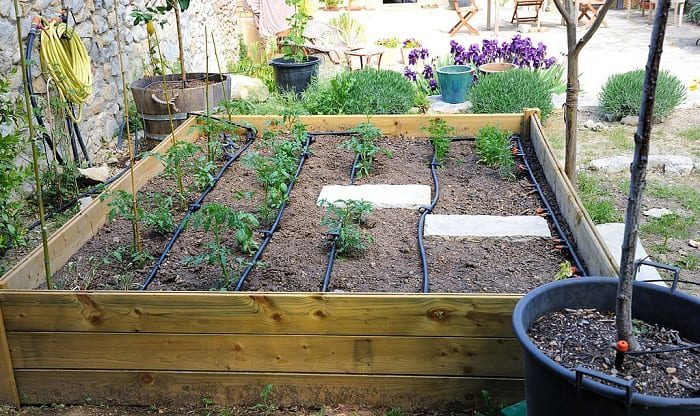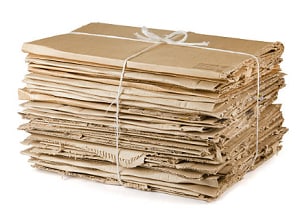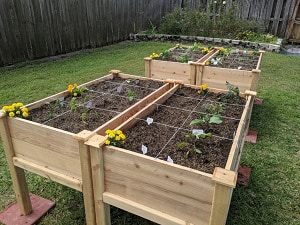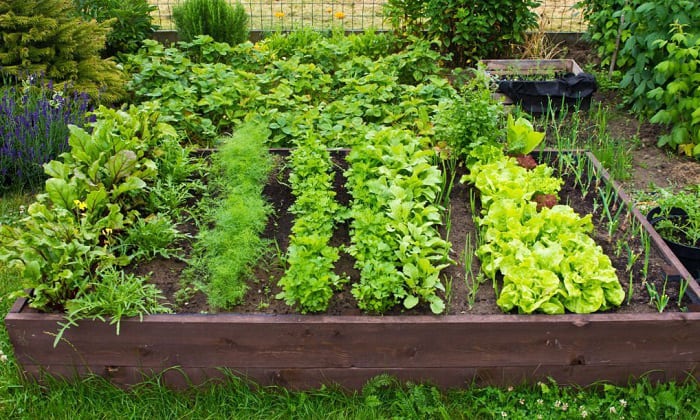Weeds are one of the challenges of gardening. They take up too much space and remove sunlight, water, and nutrients from your plants. They also invite insects that can do more damage to your crop.
Gardening in a raised garden bed is a great option to prevent weeds. It also allows easier control in improving the soil, better drainage, and lesser work for your back.
Now, you might ask, “what do I put on the bottom of a raised garden bed”?
The most used materials for a raised garden bed liner are cardboard, mulch, concrete, fabric, and plastic. They serve as a barrier between your garden soil and the ground to stop the weeds from coming through and keep out toxins and other pests in the ground.
Table of Contents
What to Put at the Bottom of Elevated Garden Bed
1. Cardboard
Cardboard is everywhere, and if you are on a budget, this is the best option for you. Putting cardboard under raised bed is very easy too.
Just spread the board across the bottom, fill it with soil, and you’re done!
However, the cardboard will decompose in 4-6 months. So, it is better to use several sheets of cardboard under raised garden beds to form a thick layer for best results.
Just make sure not to include cardboard with glossy print, for it may release toxins that will harm your plants.
2. Hardware fabric
If you are building your raised garden on concrete, hardware fabric works best as a raised garden bottom liner.
Choose galvanized hardware fabric to avoid sagging and rust over time. On top of it lay a landscape fabric to make a strong and long-lasting garden bed bottom.
How to put a hardware fabric basket under your raised bed:
- Get the measurements of the inside part of your garden bed. Add a few extra inches of slack and cut it using metal snips.
- Form the basket by imitating the shape of the bed with the extra slack bending up. Try to make the sides as even as possible.
- Push the basket to the bottom. You might need to step onto the wire inside the bed to be able to install it properly.
- Attach it into place using wide-head screws.
- You may add a layer of landscape fabric to keep the soil in place. Then, add the soil and place your plants in there.
Using a hardwire fabric on your raised garden bed with bottom provides good drainage and, at the same time, protects your plants from pests such as gophers that can eat all your crops.
3. Plastic
One variation of a raised garden bed is the one with legs. It is easier to reach and is most beneficial if you have back problems. It is ideal to use a light-weight plastic as a liner of a raised garden bed with legs.
How to use plastic as a garden bed liner:
- Get an old pool cover or plastic tarp. If they are not available, you may use a polypropylene garden bed liner from a store.
- Measure the bottom of your raised bed and cut the plastic based on it.
- Cut drainage holes on the plastic before spreading it under your raised bed to allow the water to drain.
Lining plastic as a base for raised garden bed will protect your plants from toxins that might be present in the frame of your raised garden bed.
Additionally, it is the best material to use if your soil is too dry and you need to keep it moist.
Otherwise, there are other options, including water-permeable material and plastic made of polypropylene fabric that allow better drainage.
4. Mulch
Mulch bottom of raised bed is another excellent option.
- It can be either organic, composed of materials such as chopped parts of plants and compost.
- Or you can use inorganic mulch, which include rocks, gravel, plastic, or rubber.
Both types of mulch work to prevent the weeds from growing and retain the moisture for your plants. However, organic mulch contains nutrients that are beneficial to your plants in the long run.
For example, mulching with straw in bottom of raised beds is effective in keeping the weeds out and maintaining moisture.
How to add mulch to your raised bed:
- Prepare enough mulch to cover the bottom of your raised beds and remove the weed from the soil you will add to the garden bed.
- Place a 2–4-inch layer of mulch using a shovel or your hands. Do not put more than what is needed because too much mulch may suffocate your plants. Also, make sure to place them around 3 inches away from the plant bases.
- After spreading your mulch evenly, you can add the soil layers in your planter box.
What Is the Recommended Soil Mix for Raised Garden Beds
According to Iowa State University Extension and Outreach, light, well-drained soils should be used in raised beds with closed bottom.
You can make a great soil mix of your own by preparing an equal part of topsoil, organic material (leaves, ground bark, composted manure), and coars sand and mixing them all.
Important notes:
- Check if the compost is mature enough.
- If you are getting soil from another place, check thoroughly for pathogens or toxins harmful to plants.
- Make sure that the compost is of good quality. It should be moist but not sticky or greasy. It should not smell of ammonia and should have a pH level of 7.2-7.8.
Conclusion
A raised garden bed has many benefits. It gives you more control over the soil, protects your plants from weeds and other pests underground, and requires less maintenance. Many materials can be used on a raised garden bed bottom, including cardboards, mulch, hardware fabric, and plastic.
So, what do I put on the bottom of a raised garden bed? It may depend on your budget, the availability of the material near you, and their advantages and disadvantages. We hope we can help you choose based on the information from our post.
Related articles about garden bed:
- Recommended depth of raised garden bed
- Raised garden beds vs in ground beds (detailed comparison)
- Quick steps to edge a garden bed
Happy gardening!

Hi, I am William – Floridayards’ digital content creator. My job is to find answers to all your concerns with thorough research and our team’s expert advice. I will also bring you honest reviews on the best products and equipment for raising your beautiful garden. Please look forward to our work!














